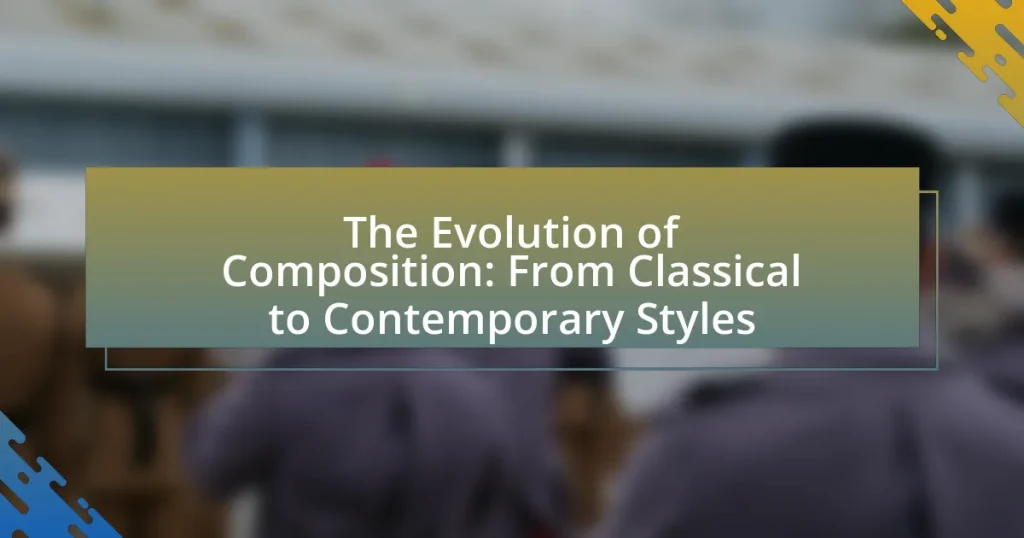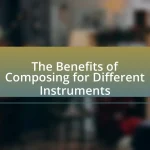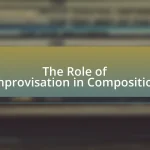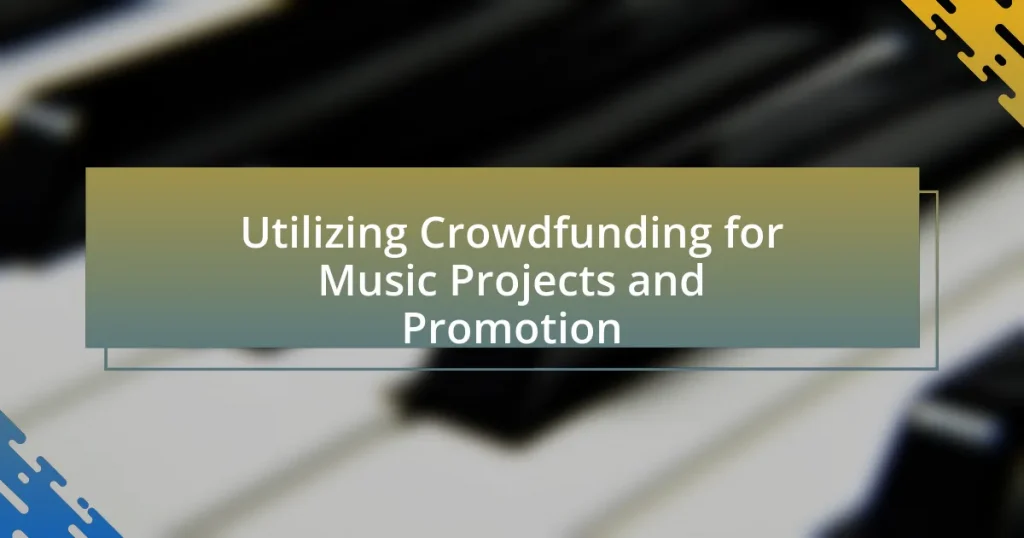The article examines the evolution of composition in music, literature, and art, tracing its historical development from the Medieval period to contemporary styles. It highlights key periods such as the Baroque, Classical, Romantic, and Modern eras, detailing how each contributed distinct techniques and forms to the art of composition. The discussion includes the influence of historical events, cultural movements, and technological advancements on compositional styles, as well as the characteristics that define classical and contemporary music. Additionally, it addresses the challenges faced by modern composers and the impact of digital technology on the distribution and accessibility of new compositions.

What is the Evolution of Composition?
The evolution of composition refers to the historical development and transformation of musical, literary, and artistic structures and styles over time. Initially, composition in music was characterized by strict forms and rules, such as those found in the works of composers like Johann Sebastian Bach during the Baroque period, where counterpoint and harmony were meticulously crafted. As time progressed, the Classical period introduced more expressive forms, exemplified by composers like Mozart and Haydn, who emphasized clarity and balance.
The Romantic era further expanded the boundaries of composition, allowing for greater emotional expression and individualism, as seen in the works of composers like Chopin and Wagner. In the 20th century, composition underwent radical changes with the advent of modernism, leading to diverse styles such as atonality and minimalism, represented by figures like Arnold Schoenberg and Steve Reich. Contemporary composition continues to evolve, incorporating technology and cross-genre influences, reflecting the complexities of modern society. This historical trajectory illustrates how composition has adapted to cultural shifts, technological advancements, and changing artistic philosophies.
How has composition changed over time?
Composition has evolved significantly over time, transitioning from structured forms in classical music to more diverse and experimental approaches in contemporary styles. In the classical era, composers adhered to strict forms such as sonatas and symphonies, emphasizing harmony and melody, as seen in the works of Bach and Mozart. As music progressed into the Romantic period, composers like Beethoven and Chopin began to explore emotional expression and individualism, leading to more complex structures and innovative harmonies.
In the 20th century, the advent of jazz, electronic music, and minimalism further transformed composition, allowing for improvisation, non-traditional scales, and new technologies. Composers such as John Cage challenged conventional notions of music, incorporating chance and silence into their works. This shift reflects a broader cultural movement towards experimentation and breaking boundaries, resulting in a rich tapestry of styles that continue to influence contemporary composition today.
What are the key periods in the evolution of composition?
The key periods in the evolution of composition include the Medieval, Renaissance, Baroque, Classical, Romantic, and Contemporary periods. Each of these periods contributed distinct styles and techniques to the art of composition.
During the Medieval period (approximately 500-1400), music was primarily vocal and sacred, with Gregorian chant being a significant form. The Renaissance (1400-1600) introduced polyphony and greater emphasis on harmony, exemplified by composers like Josquin des Prez. The Baroque period (1600-1750) saw the rise of instrumental music and the development of forms such as the concerto and opera, with figures like Johann Sebastian Bach leading the way.
The Classical period (1750-1820) emphasized clarity and balance, with composers like Mozart and Haydn refining sonata form. The Romantic period (1820-1900) focused on emotional expression and individualism, featuring composers such as Chopin and Wagner who expanded the boundaries of harmony and form. Finally, the Contemporary period (1900-present) encompasses a wide range of styles, including atonality and minimalism, with influential composers like Arnold Schoenberg and Steve Reich pushing the limits of traditional composition.
How do historical events influence compositional styles?
Historical events significantly influence compositional styles by shaping the cultural, social, and political contexts in which composers create their works. For instance, the rise of nationalism in the 19th century led composers like Dvořák and Smetana to incorporate folk melodies and rhythms into their music, reflecting their national identities. Additionally, the impact of World War I and II prompted composers such as Stravinsky and Bartók to explore new forms and dissonances, breaking away from traditional tonal structures. These shifts illustrate how composers respond to the zeitgeist of their times, adapting their styles to reflect contemporary issues and sentiments.
What are the characteristics of classical composition?
Classical composition is characterized by clarity, balance, and formality in musical structure. This style typically employs established forms such as sonata-allegro, rondo, and theme and variations, which provide a framework for composers to develop their ideas. Additionally, classical compositions often feature homophonic textures, where a primary melody is supported by harmonic accompaniment, allowing for clear melodic lines. The use of orchestration is also significant, with composers like Mozart and Haydn utilizing specific instruments to achieve distinct timbres and dynamics. Furthermore, classical music emphasizes thematic development and contrast, showcasing the evolution of musical ideas throughout a piece. These characteristics are evident in the works of prominent composers from the Classical period, which spanned roughly from 1750 to 1820, marking a significant shift from the complexity of Baroque music to a more accessible and structured form.
What forms and structures define classical composition?
Classical composition is defined by specific forms and structures such as sonata form, symphony, concerto, and string quartet. Sonata form, which typically consists of exposition, development, and recapitulation sections, serves as a foundational structure in many classical works. The symphony, characterized by its multi-movement format, often includes an allegro, adagio, scherzo, and finale, showcasing a range of emotions and themes. Concertos, featuring a solo instrument accompanied by an orchestra, highlight the contrast between the soloist and the ensemble. The string quartet, composed of two violins, viola, and cello, emphasizes intricate interplay among the instruments. These forms and structures have been pivotal in shaping the classical music repertoire, influencing composers from the Classical period through to the Romantic era and beyond.
How do harmony and melody function in classical works?
Harmony and melody in classical works function as interdependent elements that create emotional depth and structural coherence. Melody serves as the primary thematic material, often characterized by a distinct, memorable line that conveys the piece’s emotional narrative. Harmony, on the other hand, provides the underlying support and context, establishing the tonal framework and enhancing the expressive qualities of the melody.
In classical compositions, such as those by Mozart and Beethoven, harmony is meticulously crafted to complement and elevate the melodic line, often employing techniques like modulation and counterpoint to enrich the musical texture. For instance, in Beethoven’s Symphony No. 5, the interplay between the iconic four-note motif and the harmonic progression creates a sense of tension and resolution, illustrating how harmony and melody work together to drive the musical narrative forward.
What distinguishes contemporary composition from classical styles?
Contemporary composition is distinguished from classical styles primarily by its embrace of diverse musical languages and innovative techniques. Unlike classical music, which often adheres to established forms and tonal structures, contemporary composition frequently incorporates elements such as atonality, extended techniques, and electronic instrumentation. For example, composers like John Cage and Steve Reich have expanded the boundaries of rhythm and sound, utilizing unconventional methods such as chance operations and minimalism. This shift reflects a broader cultural movement towards experimentation and individual expression in music, contrasting sharply with the more formalized and hierarchical nature of classical traditions.
What new techniques and technologies are used in contemporary composition?
Contemporary composition employs techniques and technologies such as digital audio workstations (DAWs), algorithmic composition, and interactive software. Digital audio workstations, like Ableton Live and Logic Pro, allow composers to create, edit, and produce music with unprecedented flexibility and efficiency. Algorithmic composition utilizes mathematical algorithms to generate music, enabling composers to explore complex structures and patterns that may not be easily conceived manually. Interactive software, such as Max/MSP and Pure Data, facilitates real-time manipulation of sound and allows for the integration of live performance with technology. These advancements reflect a significant shift in how music is created, produced, and experienced, showcasing the fusion of art and technology in contemporary music.
How do contemporary composers approach genre and style?
Contemporary composers approach genre and style by embracing fluidity and blending elements from various musical traditions. This approach allows them to transcend traditional boundaries, often incorporating influences from genres such as jazz, electronic, and world music into their compositions. For instance, composers like John Adams and Kaija Saariaho utilize minimalist techniques alongside complex harmonic structures, demonstrating a synthesis of styles that reflects modern cultural diversity. This trend is supported by the increasing accessibility of diverse musical resources and the global interconnectedness of today’s music scene, enabling composers to experiment and innovate beyond classical conventions.
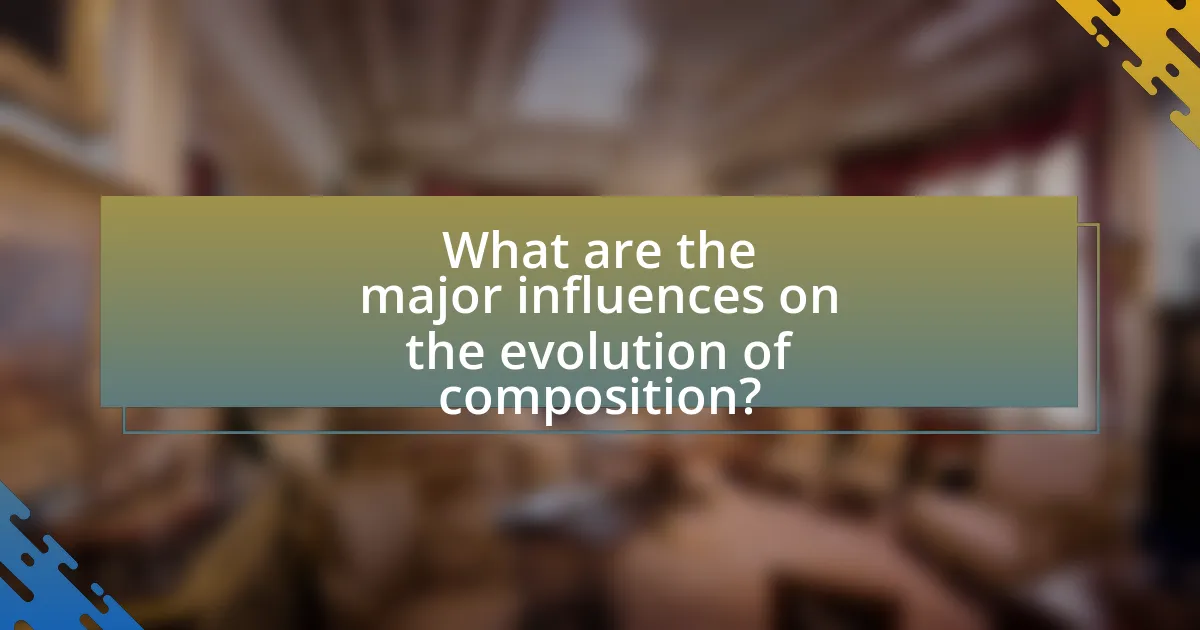
What are the major influences on the evolution of composition?
The major influences on the evolution of composition include historical context, cultural movements, technological advancements, and individual composers’ innovations. Historical context, such as the transition from the Renaissance to the Baroque period, significantly shaped compositional techniques and styles. Cultural movements, like Romanticism, emphasized emotional expression, leading to new forms and structures in music. Technological advancements, including the development of musical notation and instruments, facilitated more complex compositions. Individual composers, such as Bach, Beethoven, and Stravinsky, introduced groundbreaking ideas that transformed the landscape of music composition, demonstrating the interplay between personal creativity and broader influences.
How do cultural movements impact compositional styles?
Cultural movements significantly influence compositional styles by shaping the themes, techniques, and forms that composers adopt. For instance, the Romantic movement in the 19th century emphasized emotional expression and individualism, leading composers like Chopin and Liszt to explore new harmonic languages and expansive forms. Similarly, the emergence of jazz in the early 20th century introduced improvisation and syncopation, which transformed compositional approaches in various genres, including classical music, as seen in the works of composers like George Gershwin. These shifts demonstrate that cultural contexts not only inspire new ideas but also dictate the evolution of musical language and structure, reflecting societal values and artistic priorities of their time.
What role does technology play in shaping modern composition?
Technology plays a crucial role in shaping modern composition by providing tools that enhance creativity, streamline the writing process, and facilitate collaboration. Digital platforms such as word processors, music composition software, and online collaboration tools allow composers and writers to experiment with ideas more freely and efficiently. For instance, software like Sibelius and Finale enables musicians to compose and arrange music with precision, while platforms like Google Docs allow multiple authors to work on a document simultaneously, fostering real-time feedback and innovation. The integration of technology in composition has also democratized access to resources, enabling a wider range of voices and styles to emerge in contemporary works.
How do social and political contexts affect musical expression?
Social and political contexts significantly influence musical expression by shaping the themes, styles, and accessibility of music. For instance, during the Civil Rights Movement in the United States, artists like Nina Simone and Sam Cooke used their music to address social injustices, reflecting the political climate and resonating with the struggles of marginalized communities. Similarly, the rise of protest music in the 1960s, exemplified by Bob Dylan’s “The Times They Are a-Changin’,” illustrates how societal issues can inspire lyrical content and musical form. Historical events, such as wars or revolutions, often lead to the emergence of specific genres or movements, as seen with the anti-war sentiments in folk and rock music during the Vietnam War era. Thus, social and political contexts serve as catalysts for musical innovation and expression, directly impacting the creation and reception of music throughout history.
What are the contributions of key composers throughout history?
Key composers throughout history have significantly shaped the evolution of music through their innovative techniques and styles. For instance, Johann Sebastian Bach contributed to the development of counterpoint and harmony, influencing Western music’s structural foundations. Ludwig van Beethoven expanded the symphonic form and introduced emotional depth, paving the way for Romantic composers. Wolfgang Amadeus Mozart perfected operatic structure and melody, establishing standards for future compositions. Claude Debussy introduced impressionism, altering perceptions of tonality and texture. Igor Stravinsky’s use of rhythm and dissonance in works like “The Rite of Spring” revolutionized 20th-century music. Each of these composers not only advanced musical theory and practice but also inspired generations of musicians, ensuring their lasting impact on the art form.
Who are the pivotal figures in classical composition?
The pivotal figures in classical composition include Johann Sebastian Bach, Ludwig van Beethoven, Wolfgang Amadeus Mozart, and Franz Joseph Haydn. Johann Sebastian Bach is renowned for his intricate counterpoint and mastery of harmony, influencing countless composers after him. Ludwig van Beethoven is celebrated for his innovative approach to form and emotional depth, bridging the Classical and Romantic eras. Wolfgang Amadeus Mozart is known for his exceptional melodic invention and clarity of structure, which set standards for future compositions. Franz Joseph Haydn is often referred to as the “Father of the Symphony” and “Father of the String Quartet,” establishing foundational forms and styles in these genres. Each of these composers significantly shaped the development of Western classical music, leaving a lasting legacy that continues to influence contemporary styles.
Which contemporary composers are redefining the art of composition?
Contemporary composers redefining the art of composition include John Adams, Kaija Saariaho, and Caroline Shaw. John Adams is known for his minimalist style and operas like “Nixon in China,” which have expanded the boundaries of traditional opera. Kaija Saariaho’s innovative use of electronics and textures in works such as “L’amour de loin” showcases new sonic possibilities in composition. Caroline Shaw, the youngest recipient of the Pulitzer Prize for Music, incorporates elements of folk and classical music in her compositions, exemplified in her piece “Partita for 8 Voices.” These composers are pushing the limits of musical form and expression, influencing the trajectory of contemporary music.
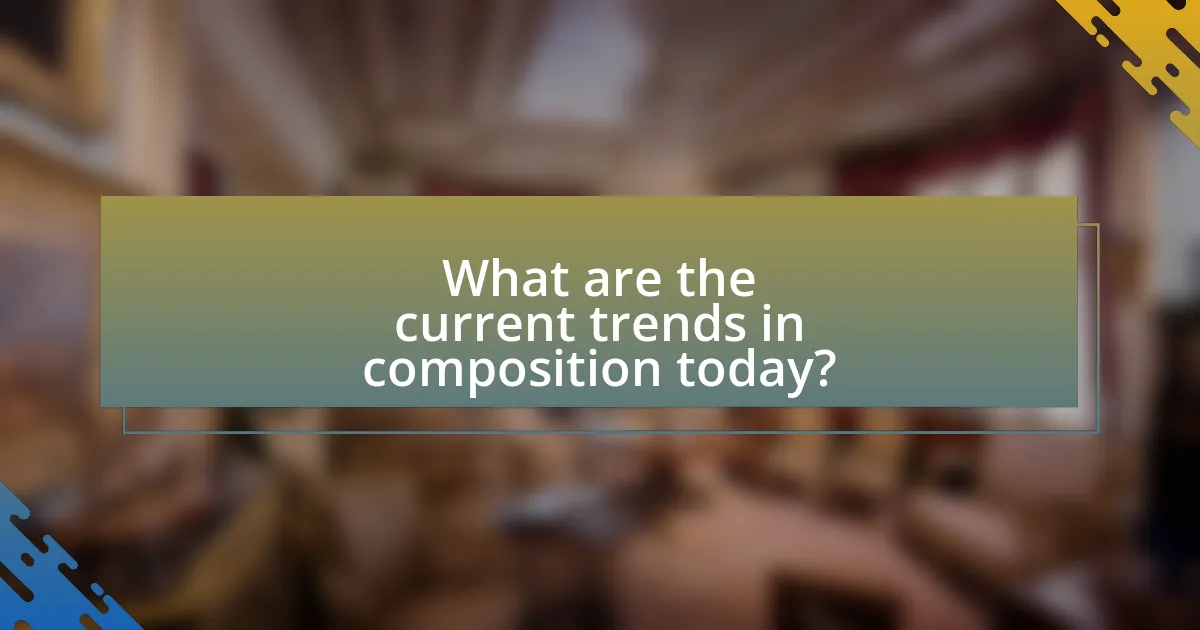
What are the current trends in composition today?
Current trends in composition today include the integration of technology, the blending of genres, and an emphasis on diversity and inclusivity. Composers increasingly utilize digital tools and software for creation and collaboration, allowing for innovative soundscapes and accessibility. The blending of genres, such as classical with electronic or hip-hop, reflects a shift towards cross-genre experimentation, appealing to broader audiences. Additionally, there is a growing focus on representing diverse voices and cultural backgrounds in compositions, as seen in initiatives promoting underrepresented composers and styles. These trends are supported by organizations like the American Composers Forum, which advocates for inclusivity in the arts.
How is collaboration influencing modern composition?
Collaboration is significantly influencing modern composition by fostering diverse creative inputs and enhancing innovation. In contemporary music, artists frequently collaborate across genres, leading to unique soundscapes that blend different styles and cultural influences. For instance, the rise of digital platforms has enabled musicians from various backgrounds to work together remotely, resulting in a fusion of traditional and modern elements. This collaborative approach is evidenced by projects like “The Chainsmokers” and “Coldplay,” where cross-genre partnerships have produced chart-topping hits, demonstrating the commercial success and artistic value of collaboration in modern composition.
What are the benefits of interdisciplinary approaches in composition?
Interdisciplinary approaches in composition enhance creativity, broaden perspectives, and foster collaboration among diverse fields. By integrating knowledge from various disciplines, composers can draw on different techniques, styles, and cultural influences, leading to innovative works that reflect a richer tapestry of ideas. For instance, the collaboration between music and visual arts has historically resulted in groundbreaking compositions that engage multiple senses, as seen in the works of composers like Igor Stravinsky, who incorporated elements from ballet and theater. This blending of disciplines not only enriches the compositional process but also appeals to a wider audience, as it resonates with varied interests and experiences.
How do composers integrate various musical styles in their work?
Composers integrate various musical styles in their work by employing techniques such as fusion, borrowing, and stylistic juxtaposition. For instance, composers like Leonard Bernstein blended classical elements with jazz in works like “West Side Story,” showcasing how different genres can coexist and enhance each other. Additionally, the use of polystylistic approaches, as seen in the compositions of Dmitri Shostakovich, allows for the incorporation of multiple styles within a single piece, reflecting cultural and historical influences. This integration not only enriches the musical texture but also broadens the emotional and narrative scope of the compositions.
What challenges do contemporary composers face?
Contemporary composers face several challenges, including the saturation of the music market, the need for technological proficiency, and the struggle for financial stability. The music industry is highly competitive, with numerous artists vying for attention, making it difficult for new composers to stand out. Additionally, the rapid advancement of technology requires composers to be adept at using digital tools and software for composition and production, which can be a barrier for those who are less tech-savvy. Financially, many contemporary composers rely on grants, commissions, and performances to sustain their careers, which can be unpredictable and insufficient, leading to economic instability. These challenges highlight the complex landscape in which contemporary composers operate, necessitating adaptability and resilience.
How does the digital age affect the distribution of new compositions?
The digital age significantly enhances the distribution of new compositions by utilizing online platforms and social media for immediate access and global reach. This transformation allows composers to share their work instantly with audiences worldwide, bypassing traditional gatekeepers like record labels and publishers. For instance, platforms such as Spotify and SoundCloud enable artists to upload their compositions directly, resulting in a democratized music landscape where emerging talents can gain visibility without substantial financial investment. According to a 2021 report by the International Federation of the Phonographic Industry, digital music revenues accounted for 62% of the global recorded music market, illustrating the profound impact of digital distribution on the accessibility and consumption of new compositions.
What are the common misconceptions about contemporary composition?
Common misconceptions about contemporary composition include the belief that it lacks structure and is purely random. In reality, contemporary composition often employs complex forms and techniques, such as serialism and minimalism, which are meticulously crafted. Additionally, some people think that contemporary composers disregard traditional musical elements; however, many integrate aspects of harmony, melody, and rhythm in innovative ways. Furthermore, there is a misconception that contemporary music is inaccessible or elitist, while numerous contemporary works are designed to engage a broad audience, reflecting diverse cultural influences and experiences.
What practical tips can aspiring composers follow?
Aspiring composers should practice regularly to develop their skills and creativity. Consistent practice allows composers to experiment with different styles and techniques, enhancing their understanding of musical theory and composition. Additionally, studying a wide range of musical genres can provide inspiration and broaden their compositional palette. Engaging with other musicians through collaboration can also lead to new ideas and perspectives, fostering growth. Furthermore, analyzing the works of established composers helps aspiring composers understand effective structures and techniques used in successful compositions.
How can one develop a unique compositional voice?
To develop a unique compositional voice, one must engage in extensive experimentation with various musical styles and techniques. This process involves analyzing and integrating elements from diverse genres, which allows composers to identify their preferences and strengths. Research indicates that composers who actively explore different musical traditions, such as classical, jazz, and contemporary styles, often cultivate a distinctive sound that reflects their individual experiences and influences. For instance, the composer Igor Stravinsky drew from Russian folk music and Western classical traditions to create a unique voice that revolutionized 20th-century music. By continuously refining their craft through practice, collaboration, and feedback, composers can further enhance their unique compositional identity.
What resources are available for learning about composition techniques?
Books, online courses, and workshops are key resources for learning about composition techniques. Notable books include “The Complete Musician” by Steven G. Laitz, which covers fundamental concepts and practical applications in music composition. Online platforms like Coursera and Udemy offer courses such as “Music Composition” that provide structured learning and expert guidance. Additionally, workshops hosted by organizations like the American Composers Forum allow for hands-on experience and networking with professionals in the field. These resources collectively provide a comprehensive foundation for understanding and mastering composition techniques.










